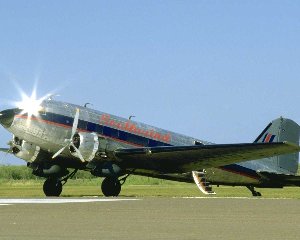The Redoubtable DC-3
Today, we ride the first modern passenger airplane. The University of Houston's College of Engineering presents this series about the machines that make our civilization run, and the people whose ingenuity created them.
Lost Horizon was one of my first movies. Have you seen it? Ronald Colman stumbling out of an airplane crash-landed in the Himalayas and being led off to the mythical city of Shangri-La. I'll not forget it. The year was 1937. The plane was one of the revolutionary new Douglas series. Those airplanes transformed passenger service in the early 1930s, and you can still find them flying now and then in remote corners of the world.
The story of the Douglas DC-3 began in 1931, when the great football player Knute Rockne died in the crash of a Fokker Trimotor. Rockne's death caused a public outcry over the quality of passenger air service. The leading airliners were then the Fokker Trimotor and its more advanced American version, the Ford Trimotor. Both were great machines in their day. But even the Trimotor was still covered with corrugated metal, had externally exposed control wires, and non-retracting landing gear.
TWA, then called Western Airlines, responded by contracting with the Douglas company to build a plane that could take off fully loaded using just one of its two engines and beat a Ford Trimotor from Santa Monica to Albuquerque. Douglas did just that in 1933 with the experimental DC-1. Then they went into production with the 14-passenger DC-2 and started service with TWA in 1934.
The DC-2 was a fine success, but airplanes would clearly have to carry more than fourteen people. TWA went back to Douglas. Their chief engineer, Bill Littlewood, wrote specifications for a third model of this remarkable new plane. The result was the 21-passenger DC-3. It entered service in 1936. By 1941, 80 percent of commercial airplanes in the United States were DC-3s. They were still our most widely used airliner as late as 1948.
The DC-3 combined all-metal stressed-skin construction, variable-pitch propellers, and retractable landing gear in a two-engine, low-wing monoplane that was safe, reliable, and easy to maintain. It brought us from airplanes of the twenties to airplanes of the forties in one step.
None of those advances were unique to the DC-3. In 1934, a whole array of flying boats also came into being with most of the DC-3's features. They were bigger than the DC-3, and they flew further. It isn't clear whether or not they were following Douglas's lead or acting independently. But as soon as long-range airliners came into being, the day of the flying boat ended. Still, you couldn't beat the DC-3 when you wanted flights of only a few hundred miles.
Nineteen thirty-four has been called the miraculous year of American flight. A spate of good ideas emerged all at once. The DC-3 was the near-perfect fusion of those ideas, and it defined modern airliners until jet planes could replace them. The DC-3 really was the airplane to take us all the way to Shangri-La.
I'm John Lienhard, at the University of Houston, where we're interested in the way inventive minds work.
(Theme music)
Allen, F., The Letter that Changed the Way We Fly. American Heritage of Invention & Technology, Fall 1988, pp. 6-13.
This is a revised version of Episode 34.

The Redoubtable DC-3
Listener Edward Morrison wrote to emend my too-simple statement that the Ford Trimotor was a clone of the Fokker Trimotor. I quote in full Mr. Morrison's useful account of each airplanes' lineage:
"Fokker's commercial airplanes, which were produced in various developments through 1933 and beyond, were derived from the design of Reinhold Platz characterized by the 1917 Fokker D.VII. They involved Fokker's specialty, the built-up multicellular plywood cantilever wing, married to his other specialty, the welded steel tube fuselage and tail surfaces. This construction continued (according to David Donald: Complete Encyclopedia of World Aircraft New York: Barnes & Noble, 1997) through 1933.
"Ford's relatively short-lived trimotor was designed by William B. Stout from his company's 2-AT Pullman after his company was acquired by Ford in 1925. It was characterized by a corrugated all-metal construction, reminiscent of Hugo Junkers' designs dating from World War I.
"Although the Ford 5-AT Trimotor resembled the Fokker Model F.XII superficially, the Ford was eight feet longer, with a two feet shorter wing span, weighed almost 2,000 pounds less empty, and was about twenty MPH slower than the Fokker, although similarly powered. They were from a different stable."